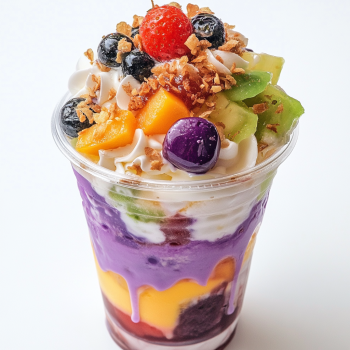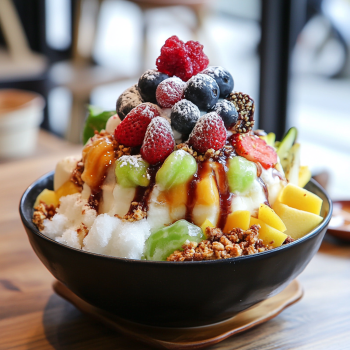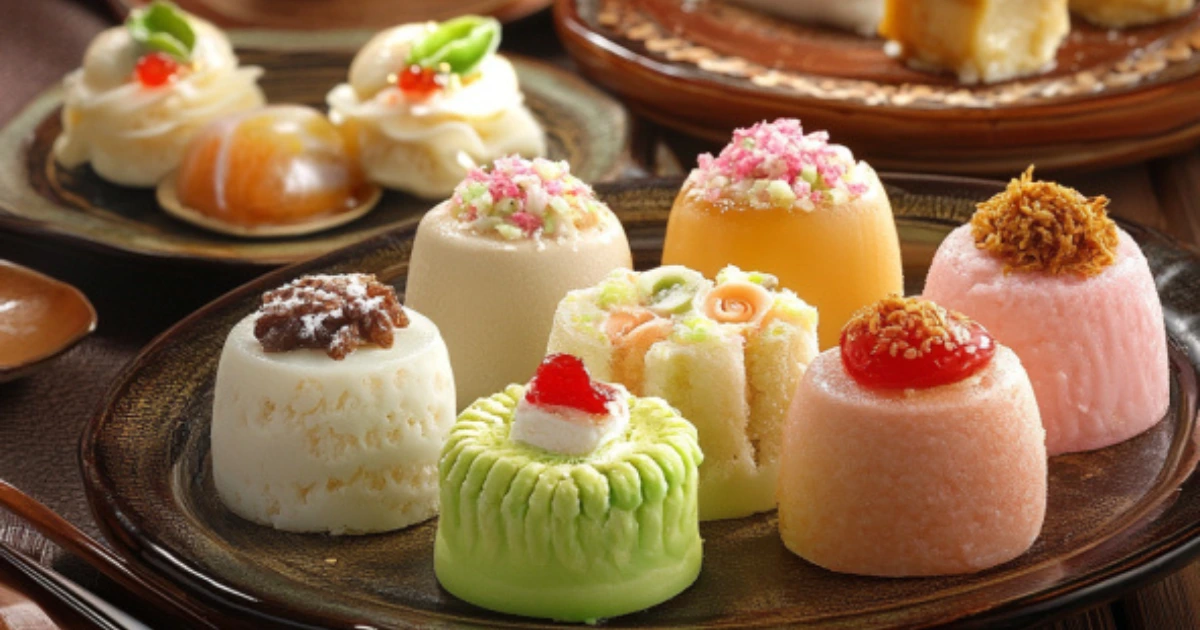What Are the Most Popular Desserts in Asia?
Asian desserts showcase a wide variety of ingredients, flavors, and preparation techniques that reflect the cultural richness and diversity across the continent. From the chewy textures of mochi to the fragrant spices in gulab jamun, desserts in Asia come in many forms, each telling its own story. The most popular desserts in Asia vary from region to region, but some desserts are universally beloved, offering a taste of the unique culinary traditions that make Asian sweets so fascinating.
Table of Contents
Introduction to Asian Desserts: Cultural Diversity and Culinary Traditions
Asian desserts are as diverse as the cultures they originate from. Each region has its own unique take on sweetness, with local ingredients and techniques influencing their preparation. In many parts of Asia, desserts are integral to social events and festivals, symbolizing good fortune, health, or prosperity. While sugar is a common ingredient, many desserts use natural sweeteners like palm sugar, honey, or stevia, creating flavors that are distinctly different from those found in Western sweets.
Notably, dessert-making in Asia often emphasizes balance. Bitterness, sourness, or saltiness often counteracts the sweetness, resulting in a more complex, well-rounded flavor profile.. As you explore desserts from countries like Japan, China, and India, you will notice that they not only focus on taste but also on texture, color, and aroma, offering a multisensory experience.
Japanese Desserts: What Are the Most Popular Sweets in Japan?
When it comes to Japanese desserts, the focus is on subtlety and harmony. One of the most famous sweets from Japan is mochi, a chewy rice cake made from pounded glutinous rice. People enjoy mochi in various forms, often filling it with sweet fillings such as red bean paste or even ice cream.. Additionally, dorayaki, a pancake-like dessert filled with sweet red bean paste, has become a beloved snack in Japan and beyond.
Another popular ingredient in Japanese sweets is matcha, powdered green tea. It is used in everything from cakes and cookies to ice cream. Matcha adds an earthy bitterness that contrasts beautifully with the sweetness of sugar. Japanese desserts are known for their lightness. They also emphasize seasonal ingredients. This focus on fresh, in-season elements makes these treats refreshing and easy to enjoy year-round.
Mochi Variations: Exploring the Different Types of Mochi Desserts in Asia
Mochi continues to be a favorite in Japan. The variations, however, are vast. Ice cream mochi is a modern twist on the classic. It features a chewy mochi exterior filled with creamy ice cream, creating a delightful contrast in texture. Daifuku is another variation. In this version, soft mochi is stuffed with sweet fillings like red bean paste, fruit, or even savory ingredients like soybeans.
In addition to these, people make zenzai, a traditional Japanese dessert, with sweet red bean soup and mochi. They often enjoy it during colder months, and it is particularly popular during New Year’s celebrations.. Each of these mochi variations offers something different but retains the beloved chewy texture and versatility that makes mochi a staple in Japanese desserts.
Wagashi and Its Symbolism: Anko-Based Sweets and Festive Treats
Wagashi refers to traditional Japanese confections, often made with anko, a sweet red bean paste. These treats are not only delicious but also rich in symbolism. They are often created to celebrate seasons, festivals, or significant life events. The preparation of wagashi is an art form. The aesthetics of the dessert are just as important as the taste.
For example, during Hanami (cherry blossom viewing season), people shape special wagashi like flowers to symbolize the beauty of the season. They typically enjoy these sweets with tea, enhancing the sensory experience.. Wagashi plays a central role in Japanese culture, particularly in the context of tea ceremonies and other ceremonial events.
Chinese Desserts: What Are the Most Popular Chinese Sweets and Delicacies?
Chinese desserts deeply intertwine with cultural traditions and symbolism. For example, people traditionally eat mooncakes during the Mid-Autumn Festival. These round pastries often get filled with lotus seed paste and salted egg yolk, symbolizing the full moon and family unity. Mooncakes vary by region, and some regions incorporate sweet or savory fillings to cater to local tastes.
Another iconic dessert is tangyuan, or sweet rice balls. Typically served in warm syrup, these chewy balls get filled with ingredients like sesame paste or red bean paste, symbolizing unity and prosperity.. These desserts highlight the Chinese appreciation for symbolism and family values, making them an integral part of many celebratory occasions.
Mooncakes Across Seasons: A Look at Regional Variations and the Mid-Autumn Festival
Mooncakes are particularly famous during the Mid-Autumn Festival. This is when families come together to celebrate the harvest and reunite with loved ones. These dense, rich cakes come in many regional varieties. Fillings range from red bean paste to black sesame, lotus seed paste, and even tea-flavored paste. The mooncake is typically eaten in small portions due to its richness. It is often accompanied by tea.
Mooncakes, while most strongly associated with the Mid-Autumn Festival, can be enjoyed throughout the year in various forms.. Each region of China offers a slightly different take on the traditional mooncake, making them an enduring and adaptable dessert beloved by many.
Tangyuan and Sweet Rice Balls: Symbolism of Unity and Prosperity
Tangyuan are another key part of Chinese dessert culture, especially during the Lantern Festival and Winter Solstice. The round shape of the rice balls symbolizes unity and togetherness. These sweet rice balls fill with a variety of fillings, including black sesame paste or peanut paste, and are often served in a sweet ginger syrup. The chewy texture of tangyuan makes it a comforting dessert enjoyed by families and friends during important gatherings.
In addition to their symbolic significance, tangyuan are known for their nourishing qualities. The warm syrup offers comfort during cold weather months. Whether filled with sweet or savory ingredients, tangyuan represents harmony and prosperity in Chinese culture.
Indian Desserts: What Are the Most Popular Desserts in India and South Asia?
In India, desserts are a significant part of every celebration, from weddings to religious festivals. Gulab jamun is one of the most beloved desserts, consisting of deep-fried dough balls soaked in a fragrant sugar syrup infused with cardamom and rose water. The combination of warm, syrupy sweetness and soft texture makes it a favorite across the country.
Jalebi is another popular Indian dessert, made by deep-frying thin, spiraled dough in a sweet syrup. Crispy on the outside and juicy on the inside, jalebi is often enjoyed as a street food snack or served during festivals. Kulfi, a traditional ice cream made from reduced milk, is a cool and refreshing treat. It’s especially popular during the hot summer months.
Syrupy Gulab Jamun: What Makes Gulab Jamun the Most Popular Dessert in India?
The key to gulab jamun lies in its preparation. The dough balls are carefully shaped, deep-fried to a golden brown, and then soaked in a warm sugar syrup. The syrup seeps into the fried dough, making each bite soft and sweet. The art of making gulab jamun lies in perfecting the frying technique. It’s essential to ensure the syrup is at the right temperature. This allows the dough to soak just enough, making it melt in your mouth..
This delicate balance of frying and soaking creates a dessert that is beloved across India and South Asia, often served at weddings, festivals, and other special events. The rich, syrupy texture of gulab jamun offers a unique experience that’s hard to replicate in any other dessert.
Kulfi: The Creamy Frozen Delight
Kulfi, a beloved frozen dessert from the Indian subcontinent, stands out for its rich and creamy texture, which results from its slow cooking process. Unlike Western ice cream, cooks simmer milk until it thickens, then add flavorings like cardamom, saffron, or pistachios. Afterward, they pour the mixture into molds and freeze it, often without incorporating air. This method creates a denser and creamier texture compared to traditional ice cream. The unique preparation gives kulfi its characteristic rich, indulgent taste.
When considering what are the most popular desserts in Asia? Kulfi stands out not only for its taste but also for its connection to Indian celebrations and street food culture. Kulfi’s popularity spans across the Indian subcontinent and beyond. Today, many international dessert menus embrace kulfi, making it a global favorite..
Regional Flavors and Innovations
As kulfi continues to evolve, various regions have introduced innovative flavors. Traditional kulfi recipes often feature flavors like mango, rosewater, or pistachio, while contemporary versions have introduced flavors such as chocolate, coconut, and green tea.. These adaptations make kulfi more accessible to diverse tastes while maintaining its traditional roots. The introduction of kulfi in fusion desserts has broadened its appeal, ensuring that its creamy texture and delightful flavor continue to be central to Asian dessert culture.
Many Southeast Asian countries have also put their own spin on kulfi, offering local flavors like jackfruit or durian, making it not just a dessert, but a representation of the rich, multicultural landscape of the region. Thus, kulfi is a perfect example of how traditional Asian desserts adapt to modern palates.
Southeast Asian Desserts: What Are the Most Popular Desserts in Southeast Asia?
Southeast Asia offers a variety of desserts that feature tropical flavors and textures, setting them apart from their Western counterparts. These desserts feature a balance of sweetness and richness, thanks to the wide range of fresh fruits, coconut, and palm sugar available.Ingredients like tapioca, sticky rice, and pandan give Southeast Asian sweets a distinct texture and depth.
When exploring what are the most popular desserts in Asia? you will undoubtedly come across many Southeast Asian delights, including halo-halo, sticky rice with mango, and cendol, which are staples of this region’s dessert culture. Each of these desserts offers a unique experience that highlights the region’s love for fresh, natural ingredients and bold flavors.Learn more in Asian Desserts for general explorations of Asian sweet traditions.
Halo-Halo: The Philippines’ Shaved Ice Delight
Halo-halo is a popular Filipino dessert that combines shaved ice with a variety of ingredients such as sweetened beans, tropical fruits, jelly, tapioca pearls, and sago. Topped with * leche flan*, ube ice cream, and coconut milk, this dessert is as visually appealing as it is delicious. Halo-halo represents a fusion of flavors and textures, making it a refreshing treat, especially during the hot summer months.

In the Philippines, people often enjoy halo-halo during celebrations and festivals. However, its accessibility also makes it a common offering in local eateries and street food stalls.. Its layered presentation and mix of sweet, salty, and creamy elements make it a favorite for those looking for a fun, unique dessert. Halo-halo exemplifies the versatility and ingenuity of Filipino dessert-making.
Sticky Rice and Mango: Thailand’s Simple Yet Elegant Dessert
One of Thailand’s most cherished desserts is sticky rice with mango. Known locally as khao neeo mamuang, this dessert combines glutinous rice, coconut milk, and ripe mangoes. The soft, sticky rice pairs perfectly with the sweet, juicy mango, and the coconut milk adds richness and a smooth texture. Its simplicity is what makes it truly delightful, as the ingredients allow each flavor to shine.
Although this dessert is popular across Southeast Asia, Thailand is known for its refined version. People typically serve the dessert as a snack or dessert during special occasions or festivals.. When thinking about what are the most popular desserts in Asia?, sticky rice with mango frequently appears as one of the top choices due to its natural sweetness and comforting consistency.
Korean Desserts: What Are the Most Popular Korean Sweets?
Korean desserts have a long history, but modern variations are beginning to catch the eye of dessert enthusiasts globally. The most famous Korean desserts include bingsu, hotteok, and yakgwa. These treats combine traditional techniques with new ingredients and textures, offering something for everyone.
The rich culinary history of Korean sweets makes them beloved not only in Korea but also among the international community. Bingsu, hotteok, and yakgwa highlight the creativity and adaptability of Korean dessert culture in the modern world.
Bingsu: The Rise of Shaved Ice Desserts in Korea
It is a popular Korean shaved ice dessert, typically topped with a variety of ingredients such as sweetened red beans, mochi, fruit, and condensed milk.. Traditionally enjoyed in the summer months, bingsu has evolved to include different variations like fruit bingsu or green tea bingsu, allowing for endless customization based on taste preferences.

The rise of bingsu has contributed to the broader trend of shaved ice desserts globally. Notably, bingsu is not only a refreshing treat but also a canvas for creativity, offering an array of flavors and toppings that appeal to diverse tastes. If you’re wondering what are the most popular desserts in Asia?, bingsu is undoubtedly a must-try dessert from Korea.
Yakgwa: What Makes This Korean Dessert So Special?
Yakgwa is a traditional Korean dessert made from deep-fried dough infused with ginger and honey. This combination creates a rich, sweet flavor that has made it a beloved treat in Korean culture. This popular treat is often served during holidays and special events. The honey glaze on the biscuit provides a satisfying sweetness that complements the crispy exterior and soft, chewy center.
Though fewer people know yakgwa outside of Korea compared to other desserts, its rich cultural history makes it a staple in Korean households. It serves as a prime example of how traditional sweets continue to thrive, especially during festivals and family gatherings. Like many other Asian desserts, people enjoy yakgwa for its balance of sweetness, texture, and its connection to Korean culture.
FAQs About Asian Desserts
When exploring what are the most popular desserts in Asia?, many questions arise regarding ingredients, preparation methods, and cultural significance.
- What is the difference between Asian and Western desserts? Asian desserts often emphasize a balance of sweetness, texture, and sometimes bitterness or sourness. They also focus on using fresh, natural ingredients, making them more varied and complex in flavor compared to Western desserts.
- Some Asian desserts may require specialized ingredients or techniques, but many are simple to prepare and can be made with easily accessible ingredients. Beginners can easily make recipes like halo-halo and sticky rice with mango, which are both delicious and straightforward to prepare.
- Can Asian desserts be made gluten-free or vegan? Yes! Many Asian desserts, such as sticky rice with mango or halo-halo, are naturally gluten-free and can easily be adapted to vegan diets by substituting ingredients.
Conclusion
In In conclusion, what are the most popular desserts in Asia? The answer reveals a delightful mix of traditional and modern sweets. These desserts showcase the rich diversity of the continent’s culinary traditions. From kulfi in India to bingsu in Korea, they highlight innovation, creativity, and cultural heritage. Whether you’re enjoying a bowl of halo-halo on a hot day or savoring delicate mochi flavors, Asian desserts offer something for every sweet tooth. They have become an integral part of global dessert culture.
The growing popularity of these sweets not only reflects the unique flavors and textures but also how food serves as a bridge between cultures, bringing people together to celebrate both tradition and innovation.


1 thought on “What Are the Most Popular Desserts in Asia?”